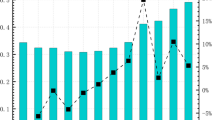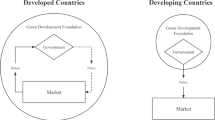Abstract
The development of green finance and the quantitative evaluation of its impact on the ecological environment provide empirical evidence for the construction of the carbon trading accounting system. Among them, carbon trading is an important part of green finance, and the accounting of businesses related to carbon emission rights has promoted the development of regional green finance. In order to explore the relationship between green finance and carbon emissions, this paper builds an analysis model of the relationship between green finance and carbon emissions based on big data and machine learning based on big data technology and machine learning technology. Moreover, this paper conducts simulation tests through the system and compares the output results with the actual situation after system simulation to verify the effectiveness of the model in this paper. From the experimental research results, it can be seen that the correlation analysis model of green finance and carbon emissions based on big data and machine learning constructed in this paper has a good performance in the correlation analysis of green finance and carbon emissions. Moreover, it is not difficult to see through the model of this paper that there is a clear correlation between green finance and carbon emissions.














Similar content being viewed by others
References
Cueva C, Roberts RE, Spencer T et al (2015) Cortisol and testosterone increase financial risk taking and may destabilize markets[J]. Sci Rep 5(1):1–16
Lee CJ, Andrade EB (2015) Fear, excitement, and financial risk-taking[J]. Cogn Emot 29(1):178–187
Bartram SM, Brown GW, Waller W (2015) How important is financial risk?[J]. J Financ Quant Anal 50(4):801–824
Cooper WW, Kingyens AT, Paradi JC (2014) Two-stage financial risk tolerance assessment using data envelopment analysis[J]. Eur J Oper Res 233(1):273–280
Montford W, Goldsmith RE (2016) How gender and financial self-efficacy influence investment risk taking[J]. Int J Consum Stud 40(1):101–106
Wanjohi SM, Wanjohi JG, Ndambiri JM (2017) The effect of financial risk management on the financial performance of commercial banks in Kenya[J]. Int J Finance Bank Res 3(5):70–81
Magendans J, Gutteling JM, Zebel S (2017) Psychological determinants of financial buffer saving: the influence of financial risk tolerance and regulatory focus[J]. J Risk Res 20(8):1076–1093
Cole ES, Walker D, Mora A et al (2014) Identifying hospitals that may be at most financial risk from Medicaid disproportionate-share hospital payment cuts[J]. Health Aff 33(11):2025–2033
Zalik A (2015) Resource sterilization: reserve replacement, financial risk, and environmental review in Canada’s tar sands[J]. Environ Plan A 47(12):2446–2464
Lucarelli C, Uberti P, Brighetti G (2015) Misclassifications in financial risk tolerance[J]. J Risk Res 18(4):467–482
Cong W (2020) Study of financial warning ensemble model for listed companies based on unbalanced classification perspective. Int J Intell Inf Technol 16(1):32–48
West T, Worthington AC (2014) Macroeconomic conditions and Australian financial risk attitudes, 2001–2010[J]. J Fam Econ Issues 35(2):263–277
Tanimura T, Jaramillo E, Weil D et al (2014) Financial burden for tuberculosis patients in low-and middle-income countries: a systematic review[J]. Eur Respir J 43(6):1763–1775
Scharding TK (2015) Imprudence and immorality: a Kantian approach to the ethics of financial risk[J]. Bus Ethics Q 25(2):243–265
Chen AS, Leung MT, Pan S et al (2020) Financial hedging in energy market by cross-learning machines. Neural Comput Appl 32:10321–10335
Wang GWY, Woo SH, Mileski J (2014) The relative efficiency and financial risk assessment of shipping companies[J]. Marit Policy Manag 41(7):651–666
Li S, Shi W, Wang J, Zhou H (2021) A deep learning-based approach to constructing a domain sentiment lexicon: a case study in financial distress prediction. Inf Process Manag 58(5):1673
Allen P, Petsoulas C (2016) Pricing in the English NHS quasi market: a national study of the allocation of financial risk through contracts[J]. Public Money Manag 36(5):341–348
Thomä J, Chenet H (2017) Transition risks and market failure: a theoretical discourse on why financial models and economic agents may misprice risk related to the transition to a low-carbon economy[J]. J Sustain Finance Invest 7(1):82–98
Sosnovska O, Zhytar M (2018) Financial architecture as the base of the financial safety of the enterprise[J]. Balt J Econ Stud 4(4):334–340
Acemoglu D, Ozdaglar A, Tahbaz-Salehi A (2015) Systemic risk and stability in financial networks[J]. Am Econ Rev 105(2):564–608
Castellano R, Cerqueti R, Rotundo G (2020) Exploring the financial risk of a temperature index: a fractional integrated approach[J]. Ann Oper Res 284(1):225–242
Cohn A, Engelmann J, Fehr E et al (2015) Evidence for countercyclical risk aversion: an experiment with financial professionals[J]. Am Econ Rev 105(2):860–885
Maggiori M (2017) Financial intermediation, international risk sharing, and reserve currencies[J]. Am Econ Rev 107(10):3038–3071
Pinelis I (2014) An optimal three-way stable and monotonic spectrum of bounds on quantiles: a spectrum of coherent measures of financial risk and economic inequality[J]. Risks 2(3):349–392
Acknowledgements
The research is supported by: The Sailing Research Project of Shandong Management University, (NO. QH2020R06)
Author information
Authors and Affiliations
Corresponding author
Ethics declarations
Conflict of interest
The authors declare no conflict of interest.
Additional information
Publisher's Note
Springer Nature remains neutral with regard to jurisdictional claims in published maps and institutional affiliations.
Rights and permissions
About this article
Cite this article
Sun, C. The correlation between green finance and carbon emissions based on improved neural network. Neural Comput & Applic 34, 12399–12413 (2022). https://doi.org/10.1007/s00521-021-06514-5
Received:
Accepted:
Published:
Issue Date:
DOI: https://doi.org/10.1007/s00521-021-06514-5




